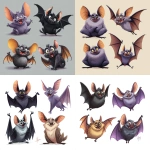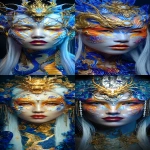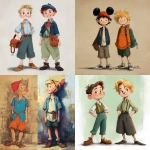Explore the Best AI Image Gallery

From Concept to Canvas: How Wearable Tech is Redefining Creative Expression
The realm of creativity has undergone a profound transformation with the advent of wearable technology. This innovative intersection of fashion, art, and technology empowers artists, designers, and innovators to push boundaries and explore novel forms of expression. From conceptualizing designs to bringing them to life, wearable tech serves as a dynamic tool, redefining the creative process and blurring the lines between imagination and reality.
Wearable Tech: A New Palette for Creative Exploration
Wearables are no longer confined to fitness tracking or communication. They have evolved into sophisticated instruments that can capture biofeedback, translate movements into art, and interact with virtual environments.
- Biometric Art: Artists are now incorporating wearable sensors to capture physiological data like heart rate, brain waves, and skin conductivity. These readings can be translated into interactive visual displays, soundscapes, or even physical sculptures, resulting in art that is deeply personal and responsive to the artists emotions and experiences.
- Gesture-Based Design: Motion sensors embedded in wearables allow designers to translate gestures into tangible creations. Architects can visualize their designs in 3D space by manipulating objects with hand movements, while fashion designers can sketch clothing patterns directly onto fabric using interactive gloves.
- Augmented Reality (AR) Experiences: AR headsets overlay digital elements onto the physical world, creating immersive and interactive environments for artists. Sculptors can visualize their creations in different scales and materials before physically constructing them, while painters can experiment with virtual brushes and textures within a digital canvas.
Ethical Considerations: Navigating Uncharted Territory
As wearable technology becomes increasingly integrated into creative processes, it raises important ethical considerations that require careful attention:
- Data Privacy and Security: Wearables collect vast amounts of personal data, including biometric information and location history. It is crucial to establish robust privacy policies and security measures to protect user data from unauthorized access or misuse.
- Bias and Representation: AI algorithms used in wearable tech can perpetuate existing biases if they are trained on skewed datasets. Ensuring diversity and inclusivity in data sets is essential to prevent the amplification of harmful stereotypes and promote equitable representation in creative outputs.
- Accessibility and Inclusivity: The development and deployment of wearable technology should prioritize accessibility for individuals with disabilities. This includes designing interfaces that are easy to use and understand, providing alternative input methods, and considering the needs of users with diverse sensory experiences.
The Future of Creative Expression: A Symphony of Innovation
The convergence of wearable technology and creative industries holds immense potential for the future.
- Personalized Art Experiences: Wearables will enable artists to create hyper-personalized art experiences that respond to individual viewers emotions, movements, and preferences.
- Immersive Storytelling: AR and VR integrated with wearables will revolutionize storytelling by immersing audiences in interactive narratives that transcend traditional boundaries.
- Collaborative Creativity: Wearables will facilitate seamless collaboration between artists, designers, and engineers, allowing them to co-create projects in real time regardless of their physical location.
As wearable technology continues to evolve, it will undoubtedly reshape the creative landscape, empowering individuals to express themselves in unprecedented ways. By embracing its potential while navigating the ethical challenges responsibly, we can unlock a future where creativity knows no bounds.








](https://images.ai-img.art/thumbnails/150/3020b8c2b6d9be07e042357107af1de10deb274a41d2b0f332684ad4b532a702.webp)



















](https://images.ai-img.art/thumbnails/150/5197af8969d850e2a43e141d41e482ccbceedebceb2a4caf9f098f943f9d1b0f.webp)
](https://images.ai-img.art/thumbnails/150/2fbd98ecfc425cfc1597779121e1c0305437067779e9c471eb64ff9615d5be98.webp)



](https://images.ai-img.art/thumbnails/150/485c8b1c747827bdc9a962f8a1919b3c259b18dd263b260208a1eae19fb85e07.webp)
](https://images.ai-img.art/thumbnails/150/8d1fe5a7a49cfc96747182431a853357913286d89258383caab2d3b4681afcb5.webp)



](https://images.ai-img.art/thumbnails/150/269414b0e541026702e9e67c67602c96162f37ff460a388b3b36314c8fc936dd.webp)










